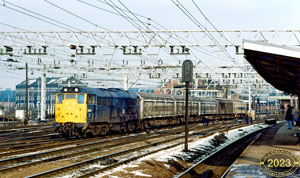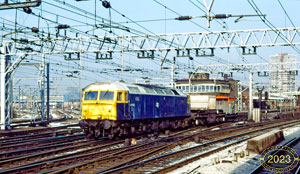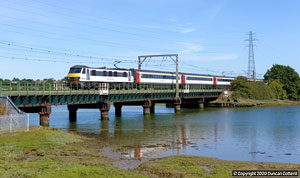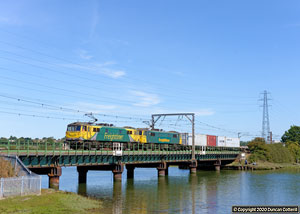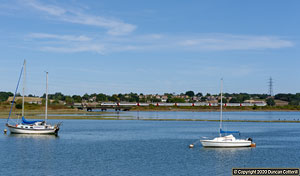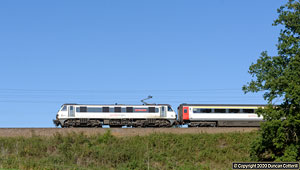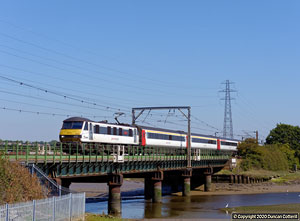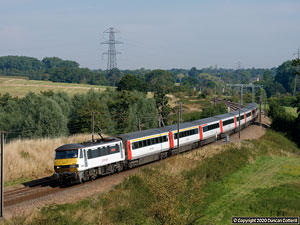The 115 mile route from London Liverpool St to Norwich was the GER's premier route and has employed a wide variety of motive power over the years. Recently it was notable for being the last British main line to retain loco hauled passenger trains, long after units had become the norm elsewhere.
The Eastern Counties Railway built the first 52 miles of the route from London to Colchester to 5 foot gauge between 1837 and 1843 but then ran into financial trouble. The line was converted to standard gauge shortly afterwards.
The Eastern Union Railway was then formed and opened another 17 miles from Colchester to Ipswich in 1846, linking up with the Ipswich and Bury Railway opened in the same year. The two lines amalgamated soon afterwards and continued to build northwards from Haughley Junction, on the I&BR 13 miles north of Ipswich, opening the final 32 miles to Norwich in 1849.
The ECR effectively took over the EUR in 1854 and both were merged into the Great Eastern Railway in 1862. The GER became part of the LNER at the Grouping in 1923 and the LNER was nationalised as part of British Railways in 1948. Since privatisation in 1997, passenger services on the line have been the responsibility of a number of franchisees, of which the current Greater Anglia, a partnership of Abellio and Mitsui is the latest.
Over the years the London - Norwich route has stood out from the crowd on several occasions. In the early 1950s it saw the first large scale deployment of the BR Standard "Britannia" Pacifics and less than a decade later, the dieselisation of principal services using some of the first class 40 diesels to be delivered.
By the late 1970s principal services were the preserve of class 47s, like on so many other lines. Stratford Depot then started to break BR's strict livery rules by customising their locos with such features as silver roofs and white wheel rims. They also kept them commendably clean at a time when scruffy engines were the norm on most lines.
Electrification reached Norwich in 1987 and Class 86 electrics replaced the class 47s, initially hauling trains in both directions but later working in push-pull mode. The 86s were themselves replaced by Class 90s and MkIII push-pull sets displaced from the West Coast Main Line by new Pendolino EMUs in 2004.
In 2020 new Stadler Flirt Class 745 EMUs replaced the Class 90s. These units are notable for being semi-articulated, each 12 car unit being formed of 6 pairs of articulated coaches. Stadler may be an unfamiliar name to some but it is an established Swiss rolling stock manufacturer that has supplied Flirt EMUs to several countries over the years.
Secondary passenger services on the route have been far less notable and, in recent years, have generally been covered by outer-suburban EMUs of classes 321 and 360. The 360s have recently moved to EMR to work London - Corby services and the 321s are in the process of being replaced by new units, this time Bombardier (now Alstom) Class 720s.
Freight traffic wasn't particularly heavy on the Great Eastern main line but that changed as Felixtowe grew to become the country's busiest container port. Freightliner dominates this traffic but GBRF and DB Cargo also have a share. The Felixtowe branch joins the GE main line at Ipswich, from where trains can follow the main line south-west to the London area and thence to points west and north. Alternatively they can head north to Haughley Junction, north of Stowmarket, then west to Peterborough to access destinations in the Midlands or northern England.
Most of Freightliner's trains are in the hands of Class 66s but pairs of Class 90 electrics, many of them former GE passenger engines, are also used, predominantly on trains to Crewe or Trafford Park via the North London Line. GBRF and DB use Class 66s on all their trains.
The Eastern Union Railway was then formed and opened another 17 miles from Colchester to Ipswich in 1846, linking up with the Ipswich and Bury Railway opened in the same year. The two lines amalgamated soon afterwards and continued to build northwards from Haughley Junction, on the I&BR 13 miles north of Ipswich, opening the final 32 miles to Norwich in 1849.
The ECR effectively took over the EUR in 1854 and both were merged into the Great Eastern Railway in 1862. The GER became part of the LNER at the Grouping in 1923 and the LNER was nationalised as part of British Railways in 1948. Since privatisation in 1997, passenger services on the line have been the responsibility of a number of franchisees, of which the current Greater Anglia, a partnership of Abellio and Mitsui is the latest.
Over the years the London - Norwich route has stood out from the crowd on several occasions. In the early 1950s it saw the first large scale deployment of the BR Standard "Britannia" Pacifics and less than a decade later, the dieselisation of principal services using some of the first class 40 diesels to be delivered.
By the late 1970s principal services were the preserve of class 47s, like on so many other lines. Stratford Depot then started to break BR's strict livery rules by customising their locos with such features as silver roofs and white wheel rims. They also kept them commendably clean at a time when scruffy engines were the norm on most lines.
Electrification reached Norwich in 1987 and Class 86 electrics replaced the class 47s, initially hauling trains in both directions but later working in push-pull mode. The 86s were themselves replaced by Class 90s and MkIII push-pull sets displaced from the West Coast Main Line by new Pendolino EMUs in 2004.
In 2020 new Stadler Flirt Class 745 EMUs replaced the Class 90s. These units are notable for being semi-articulated, each 12 car unit being formed of 6 pairs of articulated coaches. Stadler may be an unfamiliar name to some but it is an established Swiss rolling stock manufacturer that has supplied Flirt EMUs to several countries over the years.
Secondary passenger services on the route have been far less notable and, in recent years, have generally been covered by outer-suburban EMUs of classes 321 and 360. The 360s have recently moved to EMR to work London - Corby services and the 321s are in the process of being replaced by new units, this time Bombardier (now Alstom) Class 720s.
Freight traffic wasn't particularly heavy on the Great Eastern main line but that changed as Felixtowe grew to become the country's busiest container port. Freightliner dominates this traffic but GBRF and DB Cargo also have a share. The Felixtowe branch joins the GE main line at Ipswich, from where trains can follow the main line south-west to the London area and thence to points west and north. Alternatively they can head north to Haughley Junction, north of Stowmarket, then west to Peterborough to access destinations in the Midlands or northern England.
Most of Freightliner's trains are in the hands of Class 66s but pairs of Class 90 electrics, many of them former GE passenger engines, are also used, predominantly on trains to Crewe or Trafford Park via the North London Line. GBRF and DB use Class 66s on all their trains.




 options
options hide options panel
hide options panel


